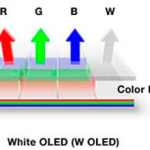In 2021, researchers in Japan made a significant breakthrough in the field of optoelectronics. Their achievement? Demonstrating a highly efficient, pure-blue organic light-emitting diode, or OLED for short. This remarkable discovery also boasts a relatively long lifetime and low cost, paving the way for the development of novel devices that are competitive with current commercial alternatives.
If you haven’t been living under a rock for the past three decades, chances are you’ve encountered OLED displays in your everyday life. Whether that be in the office, using a sat nav, catching up on your favourite Netflix show, or even when you’re mindlessly scrolling through reels before bed (we’ve all been there!), OLED technology is everywhere. The visual experience these displays provide has seamlessly integrated into our modern working day and entertainment experiences. But have you ever wondered what science underpins this transformative technology?
Now I like to imagine the album cover of Pink Floyd’s iconic and timeless masterpiece, ‘The Dark Side of the Moon’. Similarly, the commercial ‘White Organic Light-Emitting Diode’ (W OLED), developed by LG, takes white light generated from electricity, and magically transforms it into individual red, green, and blue (RGB) subpixels which act as the primary colours of the display. It’s like witnessing the metamorphosis of light to provide a vibrant spectrum of different hues resulting from unique combinations of these RGB subpixels. Just as Pink Floyd’s album cover evokes a feeling of wonder, W OLED technology captivates us with its ability to turn ordinary white light into a mesmerizing ensemble of brilliant colours.


The architecture of a W OLED device reproduced from reference [2].
In smaller devices, RGB OLEDs, first pioneered by Samsung, are used directly rather than relying on the transformation of a white OLED backlight.
So, what’s the problem? For as long as the field has existed, the scientific community have been grappling with bottleneck associated with the blue OLED. This was succinctly captured by Dr Chin-Yiu Chan who commented:
“A growing number of options exist for red and green OLEDs with excellent performance, but devices emitting high-energy blue light are more of a challenge, with trade-offs almost always occurring among efficiency, colour purity, cost and lifetime.”
Scientists not only seek to enhance the performance of blue OLEDs for smaller devices, but also aim to introduce a novel device architecture in which a blue backlight is transformed into green and red light, akin to the concept of W OLEDs. This is desirable as it allows transformation without the need for energy-wasting light filters! Which is significant amidst the concerns surrounding the current climate crisis. Both scenarios contribute to the realization of displays that are truer to life and longer lasting.
The researchers in Japan relied upon a process known as ‘hyperfluorescence’, involving two molecules, where one is responsible for harvesting the electrical energy, and the other is responsible for light emission. In my PhD, I will focus on a new class of highly performing blue-emitting materials, first presented in 2015, named MR-TADFs. The goal is to contribute to the development of a blue OLED that relies upon a single molecule which can both efficiently harvest electrical energy and emit light in line with stringent industry standards. By precisely engineering the molecular structures of known MR-TADFs, I aim to shine a light on the mechanisms behind their function and understand how their surrounding environment affects their behaviour. This will allow for the development of molecular design strategies that seek to prevent degradation, thereby increasing lifetimes. Ultimately, this work contributes to a brighter and more sustainable future.
References:
- Chan, CY., Tanaka, M., Lee, YT. et al., Stable pure-blue hyperfluorescence organic light-emitting diodes with high-efficiency and narrow emission. Nat. Photonics, 2021, 15, 203–207.
- Monkman, A., Why Do We Still Need a Stable Long Lifetime Deep Blue OLED Emitter?, ACS Appl. Mater. Interfaces, 2022, 14, 18, 20463–20467
- Kyushu University, Novel approach shows promise for overcoming the bottleneck of blue emission in displays using OLEDs, 2021, available from: https://phys.org/news/2021-01-approach-bottleneck-blue-emission-oleds.amp
- Xu Z., Tang BZ., Wang Y., Ma D., Recent advances in high performance blue organic light-emitting diodes based on fluorescence emitters, Journal of Materials Chemistry C, 2020, 8, 2614
- Hirai H., Nakajima K., Nakatsuka S., et al., One-Step Borylation of 1,3-Diaryloxybenzenes Towards Efficient Materials for Organic Light-Emitting Diodes, Angewandte Chemie, 2015, 54, 13581-13585
NanoDTC PhD Student, c2022
